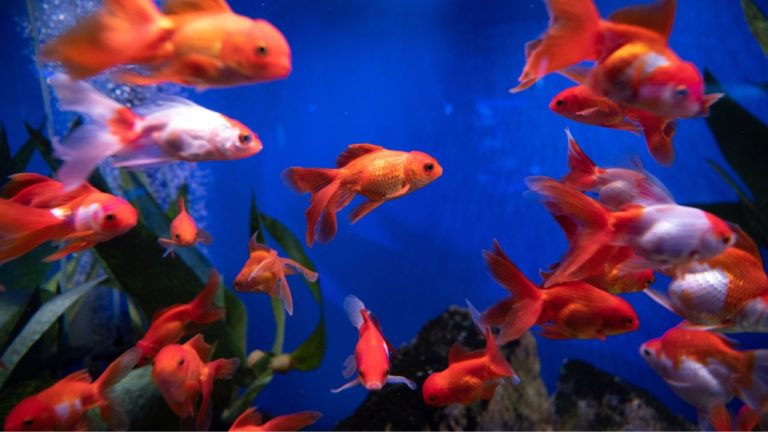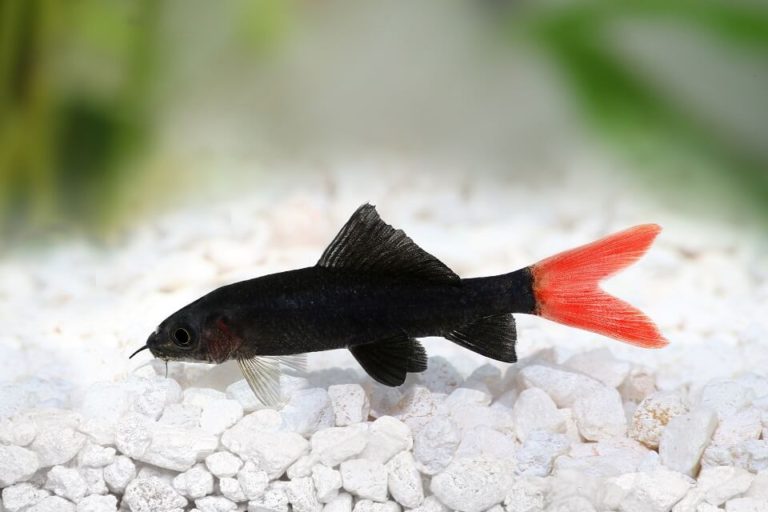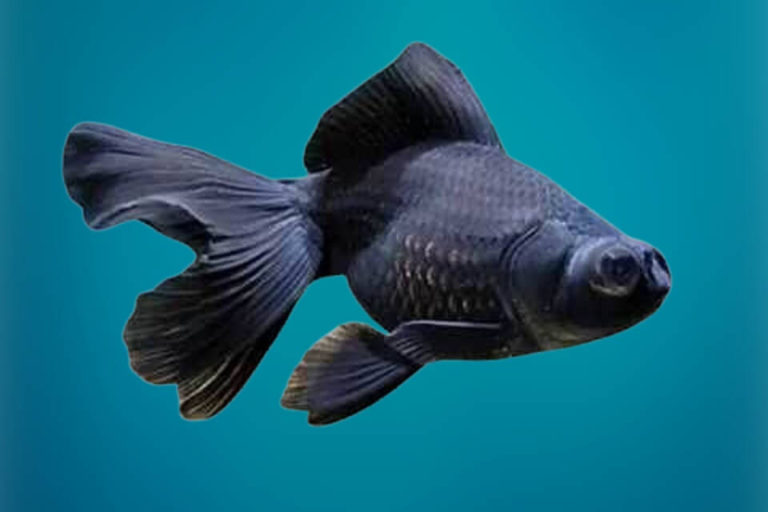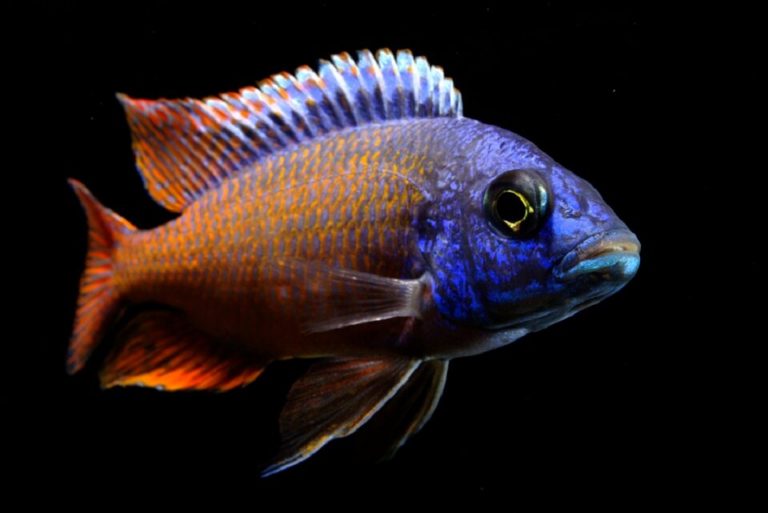Glass Catfish Care Guide: Tank Setup, Feeding, Breeding and Tank Mates
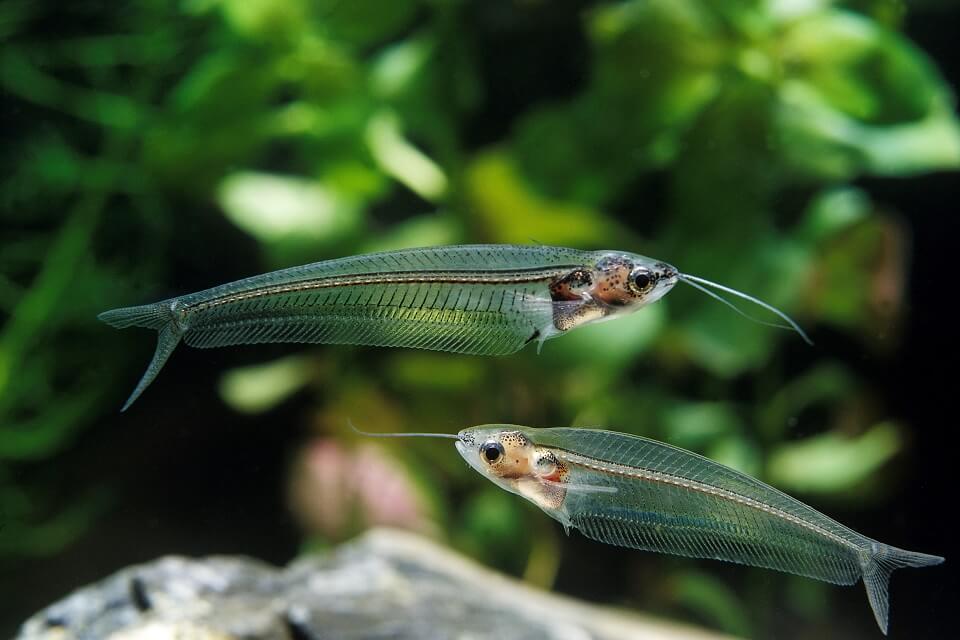
Glass Catfish is a schooling fish species will definitely catch your eyes. This is due to their amazing transparent appearance and active behavior. While the Glass Catfish is a beautiful freshwater fish species and finding it in the market is never easy.
However, you are guaranteed to bring stunning elegance to your tank when you find one. With that said, in this Glass Catfish care guide, we shall be taking you through these species complete care.
| Quick Facts: | |
|---|---|
| Common Names | : Glass catfish, Ghost catfish, Phantom catfish |
| Scientific Name | : Kryptopterus vitreolus |
| Family | : Siluridae |
| Origin | : Freshwater bodies in Thailand |
| Care Level | : Easy |
| Lifespan | : 7 - 8 years |
| Size (average) | : 4 - 6 inches long |
| Diet | : Omnivores |
| Breeding | : Egglayer |
| Social | : Schooling fish |
| Temperament | : Peaceful |
| Minimum Tank Size | : 30 gallons |
| Temperature | : 75 - 80 °F (23 - 27 °C) |
| Water Hardness | : 3 - 10 dKH |
| Water pH Level | : 6.5 - 7.5 |
Overview of Glass Catfish Species
Also known as X-ray Catfish or Phantom Catfish, or sometimes called Ghost Catfish while they are scientifically named as Kryptopterus vitreolus. Ghost Catfish is an incredible fish species for your freshwater fish tank, especially among the newbies.
Glass Catfish has transparency fins; however, they are not visible from a distance this is due to their transparency appearance.
Usually, most Catfish have relatively long barbels; however, the Ghost Catfish feature small barbels that help them detect food. Glass Catfish live in a school of fish and are often found swimming in the middle of the water. They tend to stay away from harsh light.
Therefore, floating plants are required if you want to keep them in your fish tank. By doing so, the Phantom Catfish will be able to hide beneath or behind the plants to escape direct light.
Origin and Availability
Glass Catfish Species are native to the rivers in southern parts of Thailand. Furthermore, Aquarists also collect this fish species from the river basin within Cardamom Mountain.
Along with the Asian regions, different varieties of Glass Catfish are now found in several other parts across the globe, including Africa which are slightly different from the Ghost Catfish.
Because of the shiny appearance of these species are very famous among aquatics all over the globe. They are commercially bred and distributed in the aquarium market in the world. So you might be able to find Ghost catfish in the local pet stores and also online.
Glass Catfish Typical Behavior
Glass Catfish are relatively calm in nature and are an excellent fit for a community tank. While in a captive setting, these fish will possess the same behavior, just like when they lived in the wilderness. This means that Ghost Catfish are best reared in school.
In addition to that, it is highly recommended that you provide some vegetation in their habitat to help them hide behind it when disturbed or scared. You should note that Phantom Catfish tend to be timid when introduced to a fish tank for the first time.
As time progresses, within a week or two, the Ghost Catfish will start swimming actively in a water column.
Characteristics of Glass Catfish
Glass Catfish possess some distinct characteristics, which makes them a unique fish species. Their characteristics are so unique that it is hard to miss a Glass Catfish when you come across one. Some of these unique characteristics include;
– Appearance
The most unique and outstanding feature of Glass Catfish is its appearance. Just like what their name suggests, these fish species are translucent. The main goal of this appearance is to make it relatively challenging for predators to find them.

– Colors and Special Markings
Since Glass Catfish are transparent, they possess no color whatsoever. You can clearly see through the fish, which is often the most shocking characteristic. You will be able to see the internal organ and everything that is going in their system with your naked eye.
They also don’t possess any special marking. However, the thing that stands out in this particular fish is the spine. Phantom Catfish are relatively clear; this allows you to view their spine that runs from the head to their caudal fin located at their base.
Glass Catfish Size
When it comes to size, the Glass Catfish feature sizes between 4 to 6 inches in length. Well, this is way bigger than what most of the aquarists think. Maybe it is because several transparent fish are significantly small in size.
The size of this fish species is impacted substantially by genetics along with the quality of care that they receive.
Glass Catfish Lifespan
An average Glass Catfish lifespan is approximately 7 to 8 years. Their lifespan is significantly high that will let you have ample time to enjoy and bond with them.
However, you should note that their lifespan can also be shortened considerably when you fail to provide them with the right tank condition.
Therefore, you need to ensure that you remain consistent as well as adhere to these fish requirements to help with boosting their longevity significantly.
Glass Catfish Care
Habitat, tank conditions, and care are significant for the survival of a Glass Catfish. To help boost their longevity, you will have to adhere to these significant aspects;
Originally, Glass Catfish are from the Asian region, particularly in places with moderate moving waters. Usually, these fish stay in the middle of the water column and rarely swim too far from the river bed’s safety.
Understanding their natural habitat makes it relatively easy to set up a tank that best suits their needs.
While in the wild, Ghost Catfish tend to use their barbels more often since the visibility of water is often distorted. Without their sensory organs, these fish find it hard to survive in such an environment.
Therefore, when you keep a Phantom Catfish in an aquarium, you should consider making the tank more comfortable for them; ensure that they feel at home just like how they would have felt when living in the river.
– Tank size
Tank size is a vital consideration when planning to keep Glass Catfish in an aquarium. Usually, Ghost Catfish survives best within a minimum tank size of approximately 30 gallons.
Since this fish tends to live in a school, you will need a significantly large tank; a 30 gallons tank is ideal for approximately five Glass Catfish. This is vital since this Catfish doesn’t do well when left alone.
A significantly large tank makes them relatively comfortable, allowing them to swim around and also have some social engagement along with safety that is associated with the school.
Avoid using small tanks since it will force you to keep a few of them, which comes with some disadvantages.
– Tank Setup
In addition to tank size, tank setup is a vital aspect that you will need to focus on. When it comes to tank setup, you will want to outfit the tank with an underwater gravel filter along with aquarium filters.
This will cycle through the whole water in the tank approximately three to five times per day.

In addition to that, the tank has to possess a moderate flow of water. By doing so, the tank will be able to mimic currents in the wilderness. The current has to be moderate since these fish aren’t capable of swimming against currents that are relatively high.
When it comes to decorations, you need to keep in mind that these fish are as fragile as they look; this means that they can be cut easily by a rugged seascape or rocks. Therefore, you should consider decorating your tank with driftwood or smooth rocks.
You shouldn’t also forget vegetation since they will replicate the natural habitat of this fish species.
Furthermore, you should note that these fish species tend to be destroyed by bright lights; as a result, you should consider setting up an LED light that will best suit the fish; that is, low or moderate light.
It should be installed at the top area of the fish tank to enhance comfort.
– Suitable Plants
You need to ensure that the tank is well-planted. The plants will help maintain the water clean as well as act as a great hiding spot for the fish. Therefore, the most suitable plants for use include Java Fern, Hornwort, and Java Moss which are relatively hardy.
– Water Conditions and Parameters
To boost a Glass Catfish’s longevity, you will need to monitor the water parameters more often. Since these fish tend to survive within a relatively small range, you will need to use a test kit to taste the water quality.
There is always not room for a slight error. The hardness of water has to remain significantly soft, that is, within 8 to 10 dGH (Degree of General Hardness).
In addition to that, the pH needs to be slightly acidic, which is within 6.5 to 7.0. Furthermore, nitrite and ammonia levels should be kept at 0 ppm. Nitrate levels, on the other hand, should remain within less than 50 ppm (parts per million).
The water temperature needs to be around 77 degrees Fahrenheit; nonetheless, an average of 75 to 80 degrees Fahrenheit is also accepted.
– Common Diseases
The best part about having captive Glass Catfish is that diseases are relatively rare. However, you will still have to keep an eye on some conditions such as lice and fungus.
Usually, the signs of fungal infection in this fish include white or gray development on their skin.
On the other hand, symptoms of lice tend to manifest in their behavior. When infected, they will attempt to rub in surfaces to help remove lice.
Ich is another condition you will need to watch out for. In this health condition, the fish will develop grainy white substances on its skin surface. Furthermore, the infected fish will be seen trying to gasp for air.
Becoming milky white or losing their transparency is another impending sign of death that is related to a natural cause.
Glass Catfish Diet and Feeding
Understanding the diet and feeding of a Glass Catfish is vital; to help with that, here are the essential points to note;
– What Do Glass Catfish Eat?
While in the wild, Ghost Catfish feed on zooplanktons along with other relatively small worms and invertebrates. Despite the fact they live in the middle of a water column, these fish are selective feeders.
The fish have been reported to eat baby guppies as well as mosquito larvae.
You can achieve this in an aquarium by the use of living or even frozen foods such as Daphnia, Grindal Worms, Moina, and Brine Shrimp. While in a fish tank, this fish can feed on an array of foods, including flakes and pellets.
It would help if you considered feeding the fish once or twice a day to keep them both happy and healthy.
– Are Glass Catfish Bottom Feeders?
Yes, these fish are considered bottom feeders, meaning that they are at the bottom of a water body. Furthermore, they love swimming at the bottom of the aquarium.
– Do Glass Catfish Eat Shrimp?
Yes, Ghost Catfish have been reported to feed on shrimp. As previously stated, this fish feeds on brine shrimp.
How Can We Tell a Glass Catfish Male or Female?
When it comes to gender differences, both male and female Glass Catfish have two openings located at their lower belly. One of the openings in the anus, while the remaining one represents their genitalia.
The male genitalia of this fish is raised and has a nipple-like shape. On the other hand, the female genitalia is a round opening. Usually, before spawning, a female genital area tends to be reddish and swollen.
Glass Catfish Breeding
The breeding and mating of Glass Catfish often occur during monsoon season and heavy rainfall while in the wild. However, if you want to breed this fish, you will need to keep the female and the male in a separate tank and at a temperature of 73 degrees Fahrenheit.
You will also need to feed these fish significantly high levels of live food, ensuring that they are rich in protein. By doing so, the fish will have a significant amount of energy when spawning.
During breeding, a female will lay eggs on the leaves of plants present in the aquarium. Due to that, you should consider planting plants with significantly large leaves.
Once the fish lays the egg, you should consider separating the egg from the parents, or they will end up being eaten by the parents. It is highly recommended that you store the eggs in small bowls, and once they develop, you will go ahead and keep them with their parents.
You should feed the newborn leaf juice along with baby Brine Shrimps. The fries will only take three to four days to come out of the egg.

Glass Catfish Tank Mates
As a fish keeper, it is highly recommended to know the compatible tank mates for Ghost catfish. Ensure that the tank doesn’t have any aggressive or predator fish.
Usually, this fish is known to live peacefully with species of the same size as well as schooling fish. Some of the compatible tankmates for this fish include;
- Mollies
- Neon Tetra
- Celestial Pearl Danios (Galaxy Rasbora)
- Cory Catfish
- Kuhli Loach
- Swordtails
- Panda Cory
- Dwarf Gourami
- Rummy Nose Tetra
However, it would be best if you didn’t keep these fish as tank mates for Glass Catfish;
- Cichlids
- Arowanas
- Oscars
- Sharks
- Tiger Barbs
How Many Should Glass Catfish Be Kept Together?
Glass Catfish are schooling fish; therefore, you should consider keeping approximately ten to twelve of them together in a tank. However, it would be best if you kept in mind that the tank has to be spacious and meets all the required living standards of a Phantom Catfish species.
Can Glass Catfish Live Alone?
As previously stated, Ghost Catfish are schooling fish; this means that they live best in groups. Therefore, Glass Catfish shouldn’t live alone since they tend to be happy when living in a school of fish. Living alone predisposes the fish to stress and can lead to death.
Can Glass Catfish Live with Tetras?
Glass Catfish are social fish while living in the wild. Their social nature allows them to live in harmony among various fish, which include the Tetras. The Ghost Catfish is said to live peacefully with Neon Tetras, which makes it an excellent tank mate for this fish.
Are Glass Catfish Aggressive?
Ghost Catfish are not aggressive; they are known to possess timidness along with non-aggressive behavior. It is due to this characteristic that the Ghost Catfish best live in the school.
The Glass Catfish are peaceful, active, and highly social and are known not to cause harm to any fish species in their tank. However, this fish doesn’t love dwelling with predators as well as aggressive fish that can fight or eat them.
Is Glass Catfish Hardy?
While the Ghost Catfish are highly popular, these fish are not hardy compared to most of the aquarium fish available out there. This makes it one of the best fish for a newbie fish keeper.
Final Thoughts of Keeping a Glass Catfish
As an experienced or a newbie fish keeper, having a Glass Catfish is fun and a rewarding experience that will leave you excited. Furthermore, these fish are unique, which makes them enjoyable to watch, and it will add a unique dynamic to any water tank they are added into.
You need to note that these fish are sensitive to water changes; they are also not hardy. Nonetheless, this can be managed with ease as long as you remain consistent and knowledgeable concerning the whole process. Apart from the water parameters, these fish are relatively easy to maintain.
You should also note that Ghost Catfish loves Eco-friendly surroundings; this means that you have to ensure that the fish tank is equipped with a sufficient number of plants. Java Fern, Hornwort, and Java Moss are by far the best plants you should consider using for your fish.
It would help if you adorned the tank with plants as well as keep gravels along with fine substrates in your aquarium. Since these fish are fragile, you should avoid keeping relatively sharp objects in your fish tank because they can harm the fish.
Lighting is another significant factor you will need to keep in mind. These fish don’t love harsh light; thus, you should consider using moderately low light, and it has to be located at the top of the tank to enhance the comfortability of the fish.
They are known to make excellent tank mates, offer a great look, and are very playful as well as active in nature which you will appreciate as an Aquarist.
The fish really don’t have any downside. If you are looking for a fish species to keep in your fish tank, we highly recommend you check-out the Glass Catfish and never regret making that decision.


